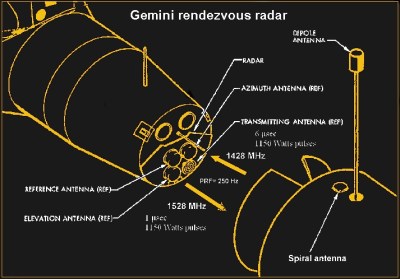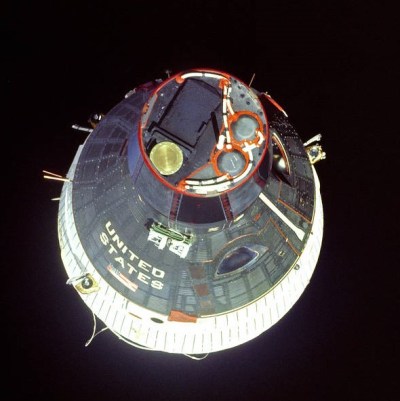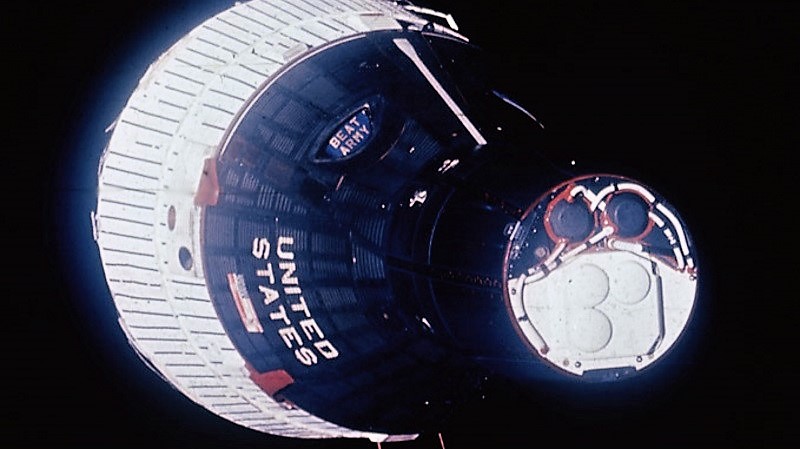In families with three kids, the middle child always seems to get the short end of the stick. The first child gets all the attention for reaching every milestone first, and the third child will forever be the baby of the family, and the middle child gets lost in-between. Something similar happened with the U.S. manned space program in the 60s. The Mercury program got massive attention when America finally got their efforts safely off the ground, and Apollo naturally seized all the attention by making good on President Kennedy’s promise to land a man on the moon.
In between Mercury and Apollo was NASA’s middle child, Project Gemini. Underappreciated at the time and even still today, Gemini was the necessary link between learning to get into orbit and figuring out how to fly to the Moon. Gemini was the program that taught NASA how to work in space, and where vital questions would be answered before the big dance of Apollo.
Chief among these questions were tackling the problems surrounding rendezvous between spacecraft. There were those who thought that flying two spacecraft whizzing around the Earth at 18,000 miles per hour wouldn’t work, and Gemini sought to prove them wrong. To achieve this, Gemini needed something no other spacecraft before had been equipped with: a space radar.
Where Are You?
NASA had planned extensively for the Gemini rendezvous maneuvers, building a special spacecraft just for the purpose. The Gemini-Agena Target Vehicle (GATV) was an Agena-D rocket equipped with a docking adapter into which the nosecone of a Gemini capsule could fit. The unmanned GATV would be launched separately and inserted into orbit, with a manned Gemini launched shortly afterward. The mission plan was for the Gemini crew to locate the GATV, catch up to it, and perform the docking maneuver.
Even in low Earth orbit, space is a big place, and finding the GATV could prove to be a problem. To fix this, NASA provided the GATV with both optical beacons and a radar transponder. Rather than rely on reflections from a radar set aboard the Gemini, the GATV transponder would transmit a signal a short time after receiving an interrogation signal from the Gemini. This was to avoid the problem of getting accurate measurements of distance and velocity at the close ranges needed for docking maneuvers. The transponder delay was sufficient for the Gemini radar to switch from transmit to receive; the radar would then subtract the delay time to calculate range and relative speed, or range rate.

On the Gemini side, the rendezvous radar was a compact package riding in the very tip of the capsule. The business end was four flat fiberglass discs with interlaced spiral elements wound from center to edge. There was a single transmit antenna and three receive antennas, one each for azimuth and elevation, and one reference antenna. The three antennas were carefully arranged relative to the long axis of the spacecraft, and the azimuth and elevation antennas had servos to rotate them on their axes. The servos would rotate each antenna until the phase of the signal matched the phase of the fixed reference antenna; the angle of the antennas would then be used to calculate the angle to the target in two dimensions.
The range/range-rate meter in the cockpit was a critical instrument for the astronauts. It had to show the distance accurately over a range of 300,000 feet down to zero feet, and it had to indicate that the closing rate was safe for the current distance; the closer the vehicles, the slower the rate should be. The range/range-rate instrument was driven by the analog output from the radar — there was also a digital output that fed into the Gemini computer for navigational calculations. By ramping up a voltage along a linear curve starting at the moment when the transmitter fired and stopping it when the transponder signal was received, a current to drive the range meter was produced.
First Contact
Despite all the careful planning, the first tests of the rendezvous radar did not go according to plan. Gemini 5, the dress rehearsal for the first rendezvous mission, was supposed to test the radar using a Radar Evaluation Pod, which was essentially the transponder from GATV which the crew could use to practice. The pod was released, but fuel cell problems on the capsule prevented the crew from completing the experiments.

The next mission, Gemini 6, was scrubbed in dramatic fashion. After the Agena rocket with the GATV to be used for rendezvous exercises exploded two minutes into its flight, NASA scrambled to salvage what it could. They decided to launch Gemini 7 with astronauts Jim Lovell and Frank Borman as scheduled, but with a GATV transponder in the nose, letting the spacecraft serve as the target vehicle. The original Gemini 6 was renamed Gemini 6A, and astronauts Tom Stafford and Wally Schirra took off to catch up with Lovel and Borman, already 11 days into a 14-day mission. The rendezvous mission went perfectly, with the two spacecraft approaching as close as a foot apart and keeping station so precisely that no correction burns of their thrusters were needed for a full 20 minutes.
With what was learned from Gemini 7/6a, four of the five remaining missions were able to rendezvous with and physically dock to their GATV — the one exception was Gemini 9a, whose GATV failed to jettison a fairing after achieving orbit. By the end of the program, NASA had reduced rendezvous and docking to practice, and everything that was learned in the process was applied to the Apollo missions, which carried rendezvous radars very similar to those used by Gemini.















I read the article thinking “I wonder what frequencies they used and how much power”. In case anyone else was pondering the same questions:
Rendezvous radar Tx: Pulse repetition frequency of 250Hz, 1150 W (~61 dBm) at a frequency of 1528 MHz
Rendezvous radar Rx: PRF of 250Hz, 1150 W at a frequency of 1428 MHz
(ref: http://www.svengrahn.pp.se/radioind/GeminiRadios/GeminiRadio.html )
Those are on the diagram embedded in the story.
I totally missed that.
If you plug 91440 meters (300,000 feet) and 1428 MHz into the Free Space Path Loss equation you get a path loss of ~14.8 dB, and since they are transmitting at 61 dBm, that is one heck of a safety margin.
Even if you plug in half the moons circumference, ~5460.5 km, into the FSPL equation that would mean a signal loss of ~50.3dB at 1428 MHz. It really does say that NASA wanted to easily pick up the radar pulses at the moon from earth 355600 km away (86.6 dB path loss).
The peak power of aircraft transponders is very similar, roughly a kilowatt at ~1GHz. The average consumption is only several 100mA at 28V. But you need a strong PSU or big caps, if you do not have a battery. :-)
I’m surprised at power of the pulses used I figure it would have only been a few tens of watts.
If the transmitter used a magnetron (not sure …), then 1 kW pulse power is no big deal; could easily be just a few watts (or tens of watts) average.
Gemini was a pretty awesome program. There were plans for continuing it including moon landings, winged spacecraft and more. Did Gemini need to be scrapped and replaced with Apollo for the space program to advance? Or was this just a political thing moving money to a new set of politicians’ friend contractors. I don’t know. https://en.wikipedia.org/wiki/Advanced_Gemini
Either way it all got scrapped for the flying brick (space shuttle) that kept at least half a century’s astronauts bogged down in low earth orbit so oh well..
The USAF was going to continue with Gemini capsules for the Manned Orbiting Laboratory, though they realized the waste in an era of automated recon satellites. The USSR had to experiment with Almaz stations before they decided on unmanned space battlestations and recon sats.
Gemini wasn’t a huge spacecraft though. Unless they modified it to give the astronauts more room it would be pretty cramped for a moon mission. Plus it lacked a airlock to transfer into a lunar lander without suiting up (and removing all the air from the cabin).
I’m sure it could have been modified to get around these issues, but clearly NASA decided that a clean sheet design would be best. Of course, Apollo would never have existed without the lessons that they’d learnt from Gemini and Mercury though, they were both stepping stones.
The Apollo vehicle had more room than the basic Gemini and a lower G reentry but Big Gemini would have been a better LEO vehicle for space station servicing than Apollo.
I wonder about moon hoax nuts. Is it only the moon landings that they think were faked? Where did their alternate universe split off from ours? Do they believe the Gemini program really happened? How about Mercury?
You are expecting a logical progression from the illogical?
B^)
I follow NASA on Google+, about a year ago they closed each article from reader comments, too many of the flat earthers and moon-landing-was-fakers and their opponents made any intelligent discourse impossible.
I actually wondered about this yesterday, for whatever reason. I’ve not done any research, but, yes, do these people only think about the moon landing itself being faked? I don’t think anybody can claim that no rocket was launched or that it was faked somehow because that was done in public.
My youngest sister is moon-landing-faker, maybe she was just too young when it happened.
I heard some great lore from one old 60’s USAF vet, an ELINT guy who I had to transport in my medic uint for about two hours. He spun such tales as intercepting the dying words of a lone stranded cosmonaut on the moon. I am reasonably sure we both knew it was all in fun like sitting around a campfire telling tall tales.
But the random dork moon hoaxers seem like they just want attention, seriously what is the gain otherwise?
I think that a good percentage of all of these ‘quirky’ pursuits and opinions are just so the person doesn’t disappear into the crowd and at least leaves a lasting memory even a negative one; or they just love to argue stupid points to feel smug
.
My grandparents watched an Apollo launch. It would of been cool but I was only 7 in 1969.
Do these hoaxers believe in ICBMs and nukes? Cause you cant have Mercury, Gemini, Vostok, and even Proton launchers without working ICBMs I once heard on the radio in the 80s a guy espousing the opinion that the secret of nuclear explosions is that they only work when aligned with rare and special astrological signs so I guess to quote The Dude “That’s just like, your opinion, man”
They just need to ignore the existence of Chang’e 5-T1, ARTEMIS P1, ARTEMIS P2 and Lunar Reconnaissance Orbiter. Oh and ignore all the images they have returned of the historic landing sites.
Photoshopped!
B^)
Spacefaring-hoaxers only need one thing to prove their point of space program being fake … steal Elon Musk’s Tesla Roadster and present it in front of cameras.
I had never thought of the Gemini mission as a “middle child”, but it is plausible the way you describe it.
As a child, I was too young to remember much about the Mercury program, but JFK and John Glenn were heroes. As the Gemini program began and continued on to the Apollo programs, I grew in knowledge and discovery as they did.
Better analogy is that Atlas was kindergarten, Gemini was a teenager and Saturn was the adult
And the Space Shuttle was the red-headed stepchild!
B^)
The first Gemini 6A launch attempt was *much* more dramatic than the 6 attempt: https://www.youtube.com/watch?v=htmd4BrNJ5k
I watched that one live (on TV) when I was a kid … very scary.
And you’re not the only one.
“BEAT ARMY” in the window of the capsule on the lead photo.
B^)
Lol went back to see it
Ugh feet, what a PITA….
What is funny is that to me feet, knots, and nautical miles are a weird set-aside aviation(and nautical) measurement. Well not nautical miles for navigation as they should be the basis for other navigational measurement of degrees, minutes, and seconds of angle on earth vs the km a sort of random measurement based on the weight and volume of a cube of water.
If we want km we should learn mils in school not 360 degrees.
Don’t get me wrong metric is a dream for regular use but we have to dump degrees which feels like an old imperial measurement, seems mils are mostly used in NATO ground forces and by gun nuts for now.
https://en.wikipedia.org/wiki/Milliradian
” seems mils are mostly used in NATO ground forces”
IOW, the .mil’s use mils!
B^)
Why is 6400 more metric than 360?
Imagine this – you have 36°24’15.6”…now convert that into degrees only (with a very long decimal), so you can use it in calculations :P
also, radians are the official derived SI unit, degrees of angle are not
Odd but did you know that exactly 1000watts of solar energy falls on exactly 1 square meter of area at the earth’s equator?
Hows that for a rather spooky coincident,eh?
Ah, No.
1050 or 1120 W/M^2 varying by about 0.1% due to plenty of solar cycles.
https://en.wikipedia.org/wiki/Orbital_ring
Mils are good if needing high precision – but otherwise the traditional units are fine. Why change things only to change them especially to a milliradian that is a _milli_radian? That would be like measure things based on millimeter.
It is not a stretch to say that the Gemini Rendezvous Radar taught me the basic principles of radar when I was a young lad.
I spent HOURS in my college library when I was in my late teens, reading NASA Technical Reports. (Yeah, I know, nerd.) When I found the Tech Report for the Gemini Rendezvous Radar, I knew I had found a gem. The theory of operation was so crystal-clear, with good diagrams, and there were lots of references. I found them and read them. These documents taught me about beacons/cooperative targets, methods of angle tracking, methods of distance measurement, and RF concepts in radar. It led me to study other radar systems, and of course to Merrill I. Skolnik’s masterpiece, the Radar Handbook. It was an education on radar.
My senior project in college was a Doppler radar. I went on to design test equipment for many Air Force and NASA radar and communications systems, but my education began with the Gemini Rendezvous Radar.
At the age of 8, reading my ARRL Handbook, Readers’ Digest told of 2 Italian brothers who tracked a mission and recorded it, sending the tape to our Pres. The built everything. Tracking was an auto steering box at which they took turns manning it and the radio. “How’d you get the frequency?!?” “A pic of the capsule with antenna…” THAT is more meaningfull and impressive to ne. All the mo ey and engineers going to the moon?!? So what. No cooler than having a monster-truck, if you were that type of guy. Pens that write upside down? They wuda ome along, in time. Meh…